The Story
of Zero
Or, How
the Weekend Warrior Came to Naught
Or, Yet
Again Another Incredibly Arduous Self-indulgent Effusion
ZERO HERO,
the Knight of Naught, was born soon after my entry into the exotic world of
comics fandom. In the spring of 1972, I discovered the Menominee Falls
Gazette, a weekly magazine that published newspaper adventure comic strips,
and, soon thereafter, The Buyer’s Guide for Comic Fandom, a monthly
tabloid that advertised comic books for sale. Zero Hero, whose life was
confined almost entirely to fanzines published by comics fans, was my foray
into the realm of funnybook superheroicism. It was an expedition doomed at the
very outset, though, because of my growing infatuation with Zero's comrade in
arms. It's a sordid tale, so let me plunge right into it.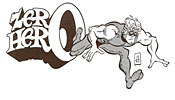
The
genesis of Zero Hero was my unpolluted desire, inspired by the comic books that
surrounded me, to draw a muscle-bound costumed hero. I'm not an illustrator of
realistic comic strip adventures, so it was a foregone conclusion that my
muscled hero would be essentially comedic, something of a spoof of superheroes.
The mcguffin was that he should be both mentally defective and physically
ineffective (his bulgy appearance to the contrary notwithstanding).
The
idea of teaming my hero with a sexy lady partner came almost at the beginning:
she would be the means by which my ineffective hero would become effective.
(The notion is fraught with subliminal meanings about the nature of the human
condition, about the yin of yang, about the population explosion, and about the
other things I like to draw besides muscled heroes in skin-tight costumes. As
soon as the team idea occurred to me, I thought it was worth exploiting for all
the significances I could find in it. But you'll have to discover those
yourself; no help from me. I need to keep some part of my psyche tucked out of
sight.)
Initially,
I called my character "The Weekend Warrior." His heroic adventures
were to be entirely dreams— the dreams of a normally underdeveloped young dolt,
who dreamt only on weekends. His "secret identity" would be his
muscular self in his dreams. Despite all his muscles, he would be as
ineffective as he was in real life—saved only by "the princess of dreamland,"
who would either vanquish his foes with dream-dust or nudge my hero awake at
the critical moment. I eventually abandoned the dream idea because, simply, I'm
lazy: I didn't want to spend all that time and energy drawing the "frame
story"—the young dolt falling asleep, waking up, yawning, etc. Besides,
dreams aren't real enough for good adventures—even humorous adventures. The
waking-up-from-a-dream bit is too tired a cliche, too much a cop-out
conclusion.
The
princess of dreamland idea stayed on though—in the form of Starbright, Princess
of Nod (the land of sleep and dreams), who saves Zero by flinging stardust into
his opponents' eyes, thereby putting them to sleep more efficiently than all
his pummeling can. The name Starbright comes from that antique kids' jingle:
"Starlight, Starbright / Grant me the wish I wish tonight," or
something like that.
Starbright
could function outside the dream-world concept, I thought, but not in any of
the real worlds we know. I needed some kind of magic kingdom, a locale that was
only vaguely real, and so I arrived at the monarchy of Nyghwold ("near
world"), a sword and sorcery setting neither here nor there. The name
suggested all sorts of punning and nonsensical linguistic possibilities. By the
time I did a stupendously glorious two-color four-pager—on display soon— the
narrative lingo was under the influence of James Joyce, Alfred Jarry, and
George Carlson.
Having
abandoned the Weekend Warrior idea, I needed another name. And "Zero
Hero" came to me through sheer rhyme and euphony. The Knight of Naught, an
equally poetic nick-nom de guerre, was the coinage of someone else, a
friend and fan, whose name, alas, I’ve forgotten. Zero’s real name, Heavy
Dootie, was, at the time I adopted it, simple contemporary slang, but I didn't
put the two words (heavy and duty) together until somewhat later. At first,
Zero Hero was merely Captain Heavy, as we see in his first adventure, posted
here in the corner of your eye. 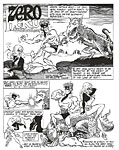
This
first fling at Zero Heroing doubled as an illustration for an ad I put in The
Buyer’s Guide (TBG), the all-ad weekly newspaper founded by Alan Light. The
Buyer’s Guide for Comics Fandom (to cite again its full name) started in
February 1971; its purpose was to offer for sale new and old comic books from
the inventories of fans whose collecting passion had been somewhat diluted by
an mercenary impulse. TBG was monthly until it went weekly with No.87 in July
1975. Bought by Krause Publishing, effective February 4, 1983 with No.482, it
was renamed The Comics Buyer’s Guide (CBG), becoming a slick monthly
magazine a year or so later.
I’m
not sure when, exactly, I committed the extravagance of doing a comic strip as
an ad that I had to pay for the publication of, but I’m guessing it was about
1973. I didn’t sell any of the comics I advertised below the Zero Hero strip, but I attracted the attention of another fan cartooner, Jim Jones. It
was a better outcome than comic book sales: we corresponded for years until his
death.
Starbright
was always named Starbright, by the way— at least in my mind. In Zero’s first
adventure, she's called "Stardust" erroneously. Probably as I was
lettering that first panel, I was thinking ahead to the third panel in which
she throws stardust at the dragon; rather than fix the error, I let it stand.
(I’ve already admitted to irredeemable indolence.)
Soon
after producing the first Zero episode, I penciled an origin for the character.
I never inked it, but the pencil scrawls are pretty clear, as you can see
nearby. 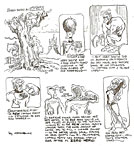 The
next appearance of my stupid-powered hero was in Bill Wilson’s The
Collector, No.29, Summer 1974, for which I did a one-page spoof of the
Captain Marvel mythos; the Big Red Cheese (as the good Captain was known) was
one of Wilson’s favorite characters, and his likeness by other fan artists ran
often in the fanzine. I repeated Zero’s origin, this time in straight text, and
to play the part of Captain Marvel, I cast Fred MacMurray, upon whom Captain
Marvel’s creator, C.C. Beck, had based the character’s facial features. The
next appearance of my stupid-powered hero was in Bill Wilson’s The
Collector, No.29, Summer 1974, for which I did a one-page spoof of the
Captain Marvel mythos; the Big Red Cheese (as the good Captain was known) was
one of Wilson’s favorite characters, and his likeness by other fan artists ran
often in the fanzine. I repeated Zero’s origin, this time in straight text, and
to play the part of Captain Marvel, I cast Fred MacMurray, upon whom Captain
Marvel’s creator, C.C. Beck, had based the character’s facial features. 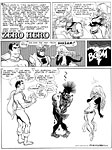
MacMurray
was a popular and highly paid Hollywood matinee idol by the late thirties when
he inspired Beck; MacMurray concluded a highly successful acting career by
playing Steve Douglas, the widowed father in tv’s “My Three Sons” (1960-1972). The Collector’s 29th issue was its last, and I did several
illustrations for it, including a caricature of Beck for the article written by
the man himself, castigating, as was his bent, the ineptitude of officials high
up in publishing enterprises who, despite their altitude, make stupid
unimaginative decisions that are at odds with artistic ones. The entire article
appears below my drawing; in common with most fanzines of the time, the
typography is by typewriter. 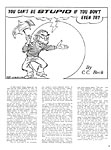
In
that summer of 1974, I also did a drawing for the cover of RBCC, the old and
revered Rocket’s Blast / Comic Collector, a periodical that combined two
other historic fanzines. The Rocket’s Blast was planned as a newsletter
for Gordon Love’s club, Science Fiction and Comic Association (later renamed
South Florida Comic Association). The primitive first issue, December 1961, was
a mere 6-8 copies reproduced by carbon paper. With No.29, April 1964, it was
combined with The Comicollector. Love’s last issue of RBCC (as it was
universally dubbed) was No.112, July 1974; he had sold it to his assistant,
James Van Hise, who continued to publish it every six weeks or so until October
1980 ; expiring with No.151, RBCC was, at the time of its demise, the
longest-lived continuously published fan publication.
The
Comicollector, the other half of RBCC’s title, was launched in September
1961 by the father of fandom, Jerry Bails, as an offshoot of his pioneering Alter-Ego magazine, which had started in March 1961. The last issue of CC, No.15, now
entitled The Comicollector and Reader and edited by Biljo White, was
dated March 1964. Thereafter, it appeared under the banner Rocket’s Blast /
Comicollector. The other part of White’s 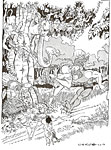 magazine, The Comic Reader, listed
forthcoming comics; another Bails invention, starting in March 1962, it resumed
its independent publication schedule in the spring of 1964 after CC was
absorbed into RBCC.. magazine, The Comic Reader, listed
forthcoming comics; another Bails invention, starting in March 1962, it resumed
its independent publication schedule in the spring of 1964 after CC was
absorbed into RBCC..
My
Zero Hero drawing, strenuously derivative of Wally Wood in its fringes, was
published on the cover of RBCC’s October 1974 issue, No.113.
A
year or so later, I did that previously alluded to “stupendously glorious
two-color four-pager,” which I used as a Christmas card that year (or maybe the
next, 1975; can’t remember and have no documentation).
I subsequently
offered the four-pager to Jim Van Hise at RBCC, and he published it in
black-and-white in No.130, dated September 1976. For that occasion, I produced
a preambulatory page with Zero and Starbright in a tree, chiefly to deploy the
new Zero Hero logo I’d developed since doing the Christmas four-pager. 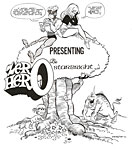 The tree scenario is
the only original artwork I’ve ever sold. The tree scenario is
the only original artwork I’ve ever sold.
Between
the drawing of the first one-page episode and the subsequent adventures,
several things happened to my character. First, I changed Zero’s costume a
little, abandoning the high collar and laced-up front (too complicated to draw
on a regular basis). And I gave him the required insignia for his chest.
(Starbright’s costume I didn’t dare tamper with. Adopted from spectacular
attire effected by an early incarnation of Milton Caniff’s Dragon Lady, it was
so delicately arranged from the start that it defied alteration.) More
importantly, I decided that I couldn’t draw muscled heroes very well, so I
bought a handful of “muscle” magazines and Burne Hogarth’s Dynamic Figure
Drawing and started sketching. The drawings of the four-pager were done and
re-done several times before I felt I had every muscle right (and I’m still not
sure).
Two
of the minor characters who debuted in that four-page frolic are favorite
marionettes that I've had hanging in the closet for just such an occasion. Pere
Hobo is based on a caricature of W.C. Fields, with a regal moustache added. His
personality derives from Jarry's Ubu Roi. And Harridan Hemistich is
really Margaret Rutherford, a memorable British actress.
Zero’s
next foray into print was in October 1977 in RBCC No.139. It was a Special Star
Wars issue, and, as you can see, I managed to get Zero and Starbright into Alex
Guinness’ world for the occasion.
This three-pager is as definitive as Zero
Hero ever got—with the “official” fine-tuned logo, a perfect invocation
with the big zero of the big Zero, so to speak. This was also Zero’s last
manifestation in pictorial narrative form. All his subsequent appearances were
cameos in spot illos created for one special occasion or another.
In
June 1976, for example, I did a drawing for the cover of TBG, which, at the
time, had the largest circulation of any fanzine. 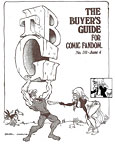 It is a pretty good drawing, I think;
I like the way the letters TBG worked out, and Zero’s muscles (which, by this
time, I was fairly adept at delineating). When it was published, however, I saw
that Light had “edited” Starbright’s neckline, reducing the amount of her bosom
that is exposed. You can see my version in the inset. Light’s re-touch covers a
little more of Starbright’s right breast; ditto, the left, destroying, in the
process, some of the defining curvature thereof. The difference is minuscule,
as you can see (I hope), but it annoyed me and my libido. It is a pretty good drawing, I think;
I like the way the letters TBG worked out, and Zero’s muscles (which, by this
time, I was fairly adept at delineating). When it was published, however, I saw
that Light had “edited” Starbright’s neckline, reducing the amount of her bosom
that is exposed. You can see my version in the inset. Light’s re-touch covers a
little more of Starbright’s right breast; ditto, the left, destroying, in the
process, some of the defining curvature thereof. The difference is minuscule,
as you can see (I hope), but it annoyed me and my libido.
Admittedly,
if it weren’t for my overweening fixation (not to say obsession) with things
mammarian, I probably wouldn’t even have noticed Light’s adjustment. But,
scandalous as it is to say, I am obsessed, so I was (and am) annoyed. And why
is a gay guy fiddling around with a woman’s breasts? (Okay: gay guys can fiddle
with women’s boobs if they want to, but why would they want to?)
I
scoffed at Light’s prudery, but I also realized that he was thinking of his
readership, which doubtless included many young people, who, as we all have
come to realize, should not be exposed to anything sexual lest they start
thinking about doing something about it. And even though the survival of the
species is udderly dependent upon their doing something about it, parental
America doesn’t want it done now.
Light
never returned my artwork either. And now you know why: probably he didn’t want
me to see, right there on my very own drawing, the desecration he had
committed.
My
last Zero for RBCC celebrated the 150th issue of the venerable zine.
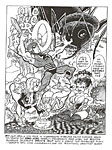 The
drawing gave me another chance to deploy the big rocky zero, and I also used
Starbright (as always) and, this time, Pere Hobo and Begonia McKenzie, Pere
Hobo’s paramour (well, the palace bawd, actually—courtesan and duty strumpet,
so to speak; if you missed this nuance in the three-pager, go back and look—and
look out for the goat, too, another emblem of lechery). After the celebration,
RBCC lasted only one more issue; Van Hise closed it down in 1980 with No.151.
And the rendition of Zero in No.150 turned out to be his last public
appearance. The
drawing gave me another chance to deploy the big rocky zero, and I also used
Starbright (as always) and, this time, Pere Hobo and Begonia McKenzie, Pere
Hobo’s paramour (well, the palace bawd, actually—courtesan and duty strumpet,
so to speak; if you missed this nuance in the three-pager, go back and look—and
look out for the goat, too, another emblem of lechery). After the celebration,
RBCC lasted only one more issue; Van Hise closed it down in 1980 with No.151.
And the rendition of Zero in No.150 turned out to be his last public
appearance.
I
had used Zero in 1977 in a New Year’s card that recognized, in typical
back-handed Zero Hero fashion, our country’s centennial—a year late; and I did
at least one other Zero Hero drawing, in which Starbright loomed more, er,
prominently than ever. I’ll let you decide which of the attendant visual aids
exemplifies her prominence.
The second of these exhibits,
the middle one, displays my final try for a chest insignia: here, it’s
incorporated into the panel border rather on than Zero’s ample chest. Pretty
fancy no matter where, eh?
All
my glorious plans for Zero's adventures began to crumble once I started fooling
around with Starbright. It was an old story. I was fascinated by the
architecture of her costume, the underslope of her breasts, the mutual
independence of these globular orbs, her gleaming smile, her luxuriant hair,
and the purely technical challenge of rendering her in the most fetching manner
possible. Before long, I'd forgotten Zero Hero entirely; I focused exclusively
on the side-kick, and she became the star. Unbeknownst to me, I'd lurched into
the not uncommon experience of many cartoonists who find their title character
supplanted in their affections by a secondary player.
In
my last drawings of the Zero Hero mythos, Starbright was a solo act. I did one
of those full-page comic book pages in which the images in adjoining panels
combine to form complete somewhat different and revealing pictures.
Pondering
these matters (as is my wont), I created a second version of the same strip,
pasting up the panels as horizontal strips, newspaper format, rather than laid
out as a single page, comic-book style; oddly, this treatment results in a much
sexier sequence by seeming to focus on parts of her anatomy without connecting
them to the rest of her body—ergo, a panting flamboyance rather than an
ingenious layout.
Enthralled
by Starbright's lush figure, I experimented with it by drawing her in every
possible position. She was the training ground for my subsequent fling at
cartooning for men's magazines (which is tediously but splendiferously
described in Harv’s Hindsight for February 29, 2012). And by the
time I started freelancing girlie cartoons, I'd exhausted my imagination's
store of poses and turned to the photography in the magazines for inspiration.
(Oh, sure.) And so I was seduced into men’s magazines and forgot the noble Zero
and his toothsome sidekick. Until now, that is.
Like
the entire male population of history, I was undone by a woman’s wiles. Or
maybe it was her chest. Whatever. Eves, they’re all Eves.
That’s
a joke, son.
But
before we part for the day, here’s another look at Zero Hero and his logo, the
 picture that began this disquisition.Zero’s headlong posture here imitates the
way the great Jack Bradbury drew his characters when they ran—leaning too far
forward, arms akimbo. I loved watching his Spunky the Junior Cowboy dash across
the landscape in this impossible but persuasive pose. So here’s Zero in homage
to Bradbury. picture that began this disquisition.Zero’s headlong posture here imitates the
way the great Jack Bradbury drew his characters when they ran—leaning too far
forward, arms akimbo. I loved watching his Spunky the Junior Cowboy dash across
the landscape in this impossible but persuasive pose. So here’s Zero in homage
to Bradbury.
Return to Harv's Hindsights |